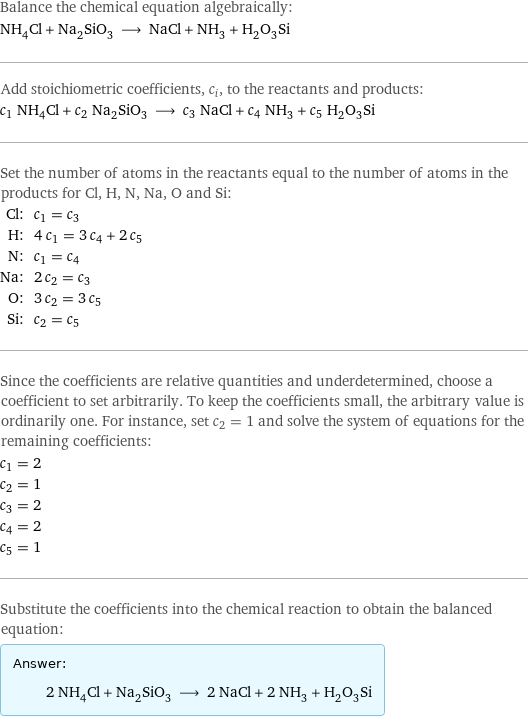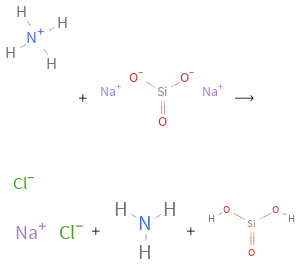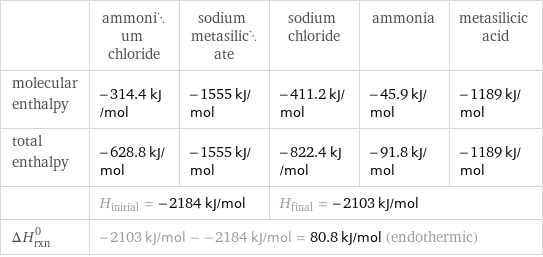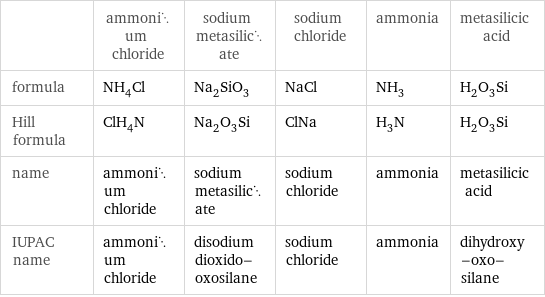Input interpretation

NH_4Cl ammonium chloride + Na_2SiO_3 sodium metasilicate ⟶ NaCl sodium chloride + NH_3 ammonia + H_2O_3Si metasilicic acid
Balanced equation

Balance the chemical equation algebraically: NH_4Cl + Na_2SiO_3 ⟶ NaCl + NH_3 + H_2O_3Si Add stoichiometric coefficients, c_i, to the reactants and products: c_1 NH_4Cl + c_2 Na_2SiO_3 ⟶ c_3 NaCl + c_4 NH_3 + c_5 H_2O_3Si Set the number of atoms in the reactants equal to the number of atoms in the products for Cl, H, N, Na, O and Si: Cl: | c_1 = c_3 H: | 4 c_1 = 3 c_4 + 2 c_5 N: | c_1 = c_4 Na: | 2 c_2 = c_3 O: | 3 c_2 = 3 c_5 Si: | c_2 = c_5 Since the coefficients are relative quantities and underdetermined, choose a coefficient to set arbitrarily. To keep the coefficients small, the arbitrary value is ordinarily one. For instance, set c_2 = 1 and solve the system of equations for the remaining coefficients: c_1 = 2 c_2 = 1 c_3 = 2 c_4 = 2 c_5 = 1 Substitute the coefficients into the chemical reaction to obtain the balanced equation: Answer: | | 2 NH_4Cl + Na_2SiO_3 ⟶ 2 NaCl + 2 NH_3 + H_2O_3Si
Structures

+ ⟶ + +
Names

ammonium chloride + sodium metasilicate ⟶ sodium chloride + ammonia + metasilicic acid
Reaction thermodynamics
Enthalpy

| ammonium chloride | sodium metasilicate | sodium chloride | ammonia | metasilicic acid molecular enthalpy | -314.4 kJ/mol | -1555 kJ/mol | -411.2 kJ/mol | -45.9 kJ/mol | -1189 kJ/mol total enthalpy | -628.8 kJ/mol | -1555 kJ/mol | -822.4 kJ/mol | -91.8 kJ/mol | -1189 kJ/mol | H_initial = -2184 kJ/mol | | H_final = -2103 kJ/mol | | ΔH_rxn^0 | -2103 kJ/mol - -2184 kJ/mol = 80.8 kJ/mol (endothermic) | | | |
Gibbs free energy

| ammonium chloride | sodium metasilicate | sodium chloride | ammonia | metasilicic acid molecular free energy | -202.9 kJ/mol | -14628 kJ/mol | -384.1 kJ/mol | -16.4 kJ/mol | -1092 kJ/mol total free energy | -405.8 kJ/mol | -14628 kJ/mol | -768.2 kJ/mol | -32.8 kJ/mol | -1092 kJ/mol | G_initial = -15034 kJ/mol | | G_final = -1893 kJ/mol | | ΔG_rxn^0 | -1893 kJ/mol - -15034 kJ/mol = 13140 kJ/mol (endergonic) | | | |
Equilibrium constant
![Construct the equilibrium constant, K, expression for: NH_4Cl + Na_2SiO_3 ⟶ NaCl + NH_3 + H_2O_3Si Plan: • Balance the chemical equation. • Determine the stoichiometric numbers. • Assemble the activity expression for each chemical species. • Use the activity expressions to build the equilibrium constant expression. Write the balanced chemical equation: 2 NH_4Cl + Na_2SiO_3 ⟶ 2 NaCl + 2 NH_3 + H_2O_3Si Assign stoichiometric numbers, ν_i, using the stoichiometric coefficients, c_i, from the balanced chemical equation in the following manner: ν_i = -c_i for reactants and ν_i = c_i for products: chemical species | c_i | ν_i NH_4Cl | 2 | -2 Na_2SiO_3 | 1 | -1 NaCl | 2 | 2 NH_3 | 2 | 2 H_2O_3Si | 1 | 1 Assemble the activity expressions accounting for the state of matter and ν_i: chemical species | c_i | ν_i | activity expression NH_4Cl | 2 | -2 | ([NH4Cl])^(-2) Na_2SiO_3 | 1 | -1 | ([Na2SiO3])^(-1) NaCl | 2 | 2 | ([NaCl])^2 NH_3 | 2 | 2 | ([NH3])^2 H_2O_3Si | 1 | 1 | [H2O3Si] The equilibrium constant symbol in the concentration basis is: K_c Mulitply the activity expressions to arrive at the K_c expression: Answer: | | K_c = ([NH4Cl])^(-2) ([Na2SiO3])^(-1) ([NaCl])^2 ([NH3])^2 [H2O3Si] = (([NaCl])^2 ([NH3])^2 [H2O3Si])/(([NH4Cl])^2 [Na2SiO3])](../image_source/25612099a4cc3d341b11386dd825dc5e.png)
Construct the equilibrium constant, K, expression for: NH_4Cl + Na_2SiO_3 ⟶ NaCl + NH_3 + H_2O_3Si Plan: • Balance the chemical equation. • Determine the stoichiometric numbers. • Assemble the activity expression for each chemical species. • Use the activity expressions to build the equilibrium constant expression. Write the balanced chemical equation: 2 NH_4Cl + Na_2SiO_3 ⟶ 2 NaCl + 2 NH_3 + H_2O_3Si Assign stoichiometric numbers, ν_i, using the stoichiometric coefficients, c_i, from the balanced chemical equation in the following manner: ν_i = -c_i for reactants and ν_i = c_i for products: chemical species | c_i | ν_i NH_4Cl | 2 | -2 Na_2SiO_3 | 1 | -1 NaCl | 2 | 2 NH_3 | 2 | 2 H_2O_3Si | 1 | 1 Assemble the activity expressions accounting for the state of matter and ν_i: chemical species | c_i | ν_i | activity expression NH_4Cl | 2 | -2 | ([NH4Cl])^(-2) Na_2SiO_3 | 1 | -1 | ([Na2SiO3])^(-1) NaCl | 2 | 2 | ([NaCl])^2 NH_3 | 2 | 2 | ([NH3])^2 H_2O_3Si | 1 | 1 | [H2O3Si] The equilibrium constant symbol in the concentration basis is: K_c Mulitply the activity expressions to arrive at the K_c expression: Answer: | | K_c = ([NH4Cl])^(-2) ([Na2SiO3])^(-1) ([NaCl])^2 ([NH3])^2 [H2O3Si] = (([NaCl])^2 ([NH3])^2 [H2O3Si])/(([NH4Cl])^2 [Na2SiO3])
Rate of reaction
![Construct the rate of reaction expression for: NH_4Cl + Na_2SiO_3 ⟶ NaCl + NH_3 + H_2O_3Si Plan: • Balance the chemical equation. • Determine the stoichiometric numbers. • Assemble the rate term for each chemical species. • Write the rate of reaction expression. Write the balanced chemical equation: 2 NH_4Cl + Na_2SiO_3 ⟶ 2 NaCl + 2 NH_3 + H_2O_3Si Assign stoichiometric numbers, ν_i, using the stoichiometric coefficients, c_i, from the balanced chemical equation in the following manner: ν_i = -c_i for reactants and ν_i = c_i for products: chemical species | c_i | ν_i NH_4Cl | 2 | -2 Na_2SiO_3 | 1 | -1 NaCl | 2 | 2 NH_3 | 2 | 2 H_2O_3Si | 1 | 1 The rate term for each chemical species, B_i, is 1/ν_i(Δ[B_i])/(Δt) where [B_i] is the amount concentration and t is time: chemical species | c_i | ν_i | rate term NH_4Cl | 2 | -2 | -1/2 (Δ[NH4Cl])/(Δt) Na_2SiO_3 | 1 | -1 | -(Δ[Na2SiO3])/(Δt) NaCl | 2 | 2 | 1/2 (Δ[NaCl])/(Δt) NH_3 | 2 | 2 | 1/2 (Δ[NH3])/(Δt) H_2O_3Si | 1 | 1 | (Δ[H2O3Si])/(Δt) (for infinitesimal rate of change, replace Δ with d) Set the rate terms equal to each other to arrive at the rate expression: Answer: | | rate = -1/2 (Δ[NH4Cl])/(Δt) = -(Δ[Na2SiO3])/(Δt) = 1/2 (Δ[NaCl])/(Δt) = 1/2 (Δ[NH3])/(Δt) = (Δ[H2O3Si])/(Δt) (assuming constant volume and no accumulation of intermediates or side products)](../image_source/661c8d60fb9233b2d1c9a250992886a5.png)
Construct the rate of reaction expression for: NH_4Cl + Na_2SiO_3 ⟶ NaCl + NH_3 + H_2O_3Si Plan: • Balance the chemical equation. • Determine the stoichiometric numbers. • Assemble the rate term for each chemical species. • Write the rate of reaction expression. Write the balanced chemical equation: 2 NH_4Cl + Na_2SiO_3 ⟶ 2 NaCl + 2 NH_3 + H_2O_3Si Assign stoichiometric numbers, ν_i, using the stoichiometric coefficients, c_i, from the balanced chemical equation in the following manner: ν_i = -c_i for reactants and ν_i = c_i for products: chemical species | c_i | ν_i NH_4Cl | 2 | -2 Na_2SiO_3 | 1 | -1 NaCl | 2 | 2 NH_3 | 2 | 2 H_2O_3Si | 1 | 1 The rate term for each chemical species, B_i, is 1/ν_i(Δ[B_i])/(Δt) where [B_i] is the amount concentration and t is time: chemical species | c_i | ν_i | rate term NH_4Cl | 2 | -2 | -1/2 (Δ[NH4Cl])/(Δt) Na_2SiO_3 | 1 | -1 | -(Δ[Na2SiO3])/(Δt) NaCl | 2 | 2 | 1/2 (Δ[NaCl])/(Δt) NH_3 | 2 | 2 | 1/2 (Δ[NH3])/(Δt) H_2O_3Si | 1 | 1 | (Δ[H2O3Si])/(Δt) (for infinitesimal rate of change, replace Δ with d) Set the rate terms equal to each other to arrive at the rate expression: Answer: | | rate = -1/2 (Δ[NH4Cl])/(Δt) = -(Δ[Na2SiO3])/(Δt) = 1/2 (Δ[NaCl])/(Δt) = 1/2 (Δ[NH3])/(Δt) = (Δ[H2O3Si])/(Δt) (assuming constant volume and no accumulation of intermediates or side products)
Chemical names and formulas

| ammonium chloride | sodium metasilicate | sodium chloride | ammonia | metasilicic acid formula | NH_4Cl | Na_2SiO_3 | NaCl | NH_3 | H_2O_3Si Hill formula | ClH_4N | Na_2O_3Si | ClNa | H_3N | H_2O_3Si name | ammonium chloride | sodium metasilicate | sodium chloride | ammonia | metasilicic acid IUPAC name | ammonium chloride | disodium dioxido-oxosilane | sodium chloride | ammonia | dihydroxy-oxo-silane
Substance properties

| ammonium chloride | sodium metasilicate | sodium chloride | ammonia | metasilicic acid molar mass | 53.49 g/mol | 122.06 g/mol | 58.44 g/mol | 17.031 g/mol | 78.098 g/mol phase | solid (at STP) | solid (at STP) | solid (at STP) | gas (at STP) | solid (at STP) melting point | 340 °C | 72.2 °C | 801 °C | -77.73 °C | 1704 °C boiling point | | | 1413 °C | -33.33 °C | density | 1.5256 g/cm^3 | 1.749 g/cm^3 | 2.16 g/cm^3 | 6.96×10^-4 g/cm^3 (at 25 °C) | 1 g/cm^3 solubility in water | soluble | soluble | soluble | | surface tension | | | | 0.0234 N/m | dynamic viscosity | | 1 Pa s (at 1088 °C) | | 1.009×10^-5 Pa s (at 25 °C) | odor | | | odorless | |
Units
